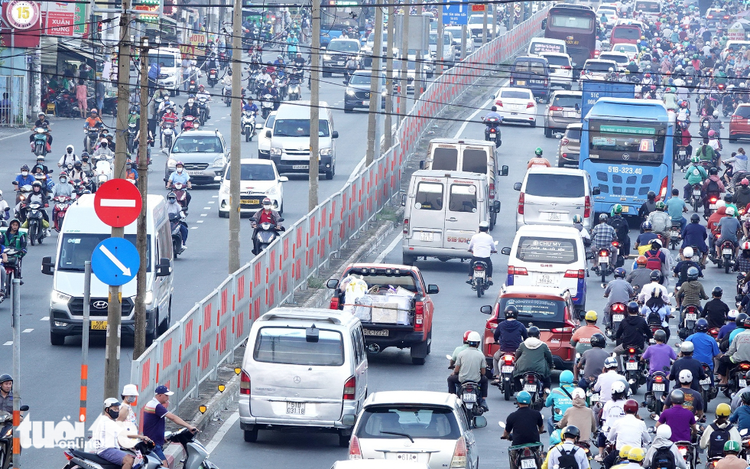
Motorcycles travel in the car lane along National Highway 13 in Ho Chi Minh City. Photo: T.T.D. / Tuoi Tre
The National Traffic Safety Committee has urged local authorities to tighten control over the issue of motorcycles straying into lanes designated for automobiles following a series of serious collisions.
One of the fundamental causes of road accidents in Vietnam is the disparity in speed, size, and maneuverability between cars and motorcycles.
Data from the committee indicated that more than 60 percent of traffic accidents on Vietnamese roads involve motorcycles.
A larger number of these accidents occur when motorcycles and cars share the same lanes, leading to dangerous conflicts in movement.
Motorcycles generally travel at slower speeds and are more prone to being overlooked, especially by vehicles like buses and trucks.
In major cities, traffic congestion is a nuisance, so separating lanes can help improve traffic flow and allows each type of vehicle to move at a reasonable speed, resulting in reduced congestion and enhanced safety for all road users.
Meanwhile, some national highways in Vietnam feature only two lanes for each direction, forcing vehicles to encroach on each other's space during overtaking maneuvers.
On roads with three lanes, mixed traffic remains common, where motorcycles, cars, and even trucks share the same space, posing a high risk of collision.
Given these conditions, the transport sector was urged to act swiftly on high-traffic routes and national highways to implement lane separation.
If immediate separation has not to be conducted, solutions such as restricting lane-sharing during peak hours, and upgrading traffic infrastructure should be adopted.
To effectively separate car and motorcycle lanes and reduce traffic incidents, the following strategies are recommended:
Expanding road infrastructure: In areas where it is possible, especially along national highways, roads should be widened to include dedicated motorcycle lanes. At busy intersections, it is necessary to consider constructing overpasses or underpasses to limit vehicle crossings and minimize conflict points.
Rational traffic zoning: Implementing logical lane and route designations based on traffic volume and types of vehicles. This may include restricting certain vehicle types during peak hours or adjusting speed limits according to real-time conditions.
Regular road maintenance: Ensuring continuous repair of deteriorating roads. Fixing common hazards such as potholes, uneven surfaces, and standing water. Road signs must also be clear, visible, and well-maintained.
Strict law enforcement: Increasing patrol frequency and enforcing penalties for lane violations and speeding. Consistent monitoring by traffic police is essential to ensure compliance and deter reckless behavior.


Max: 1500 characters
There are no comments yet. Be the first to comment.